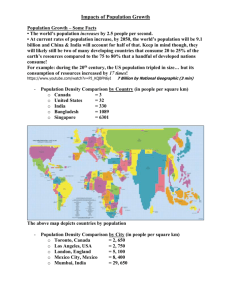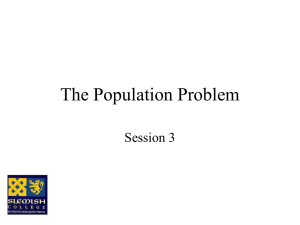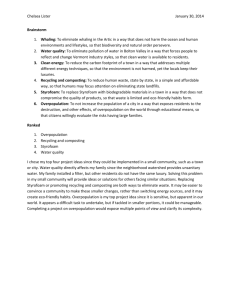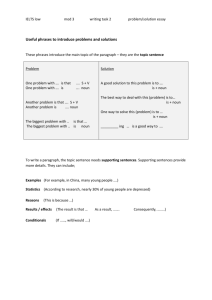Overpopulation of Domestic Animals
advertisement
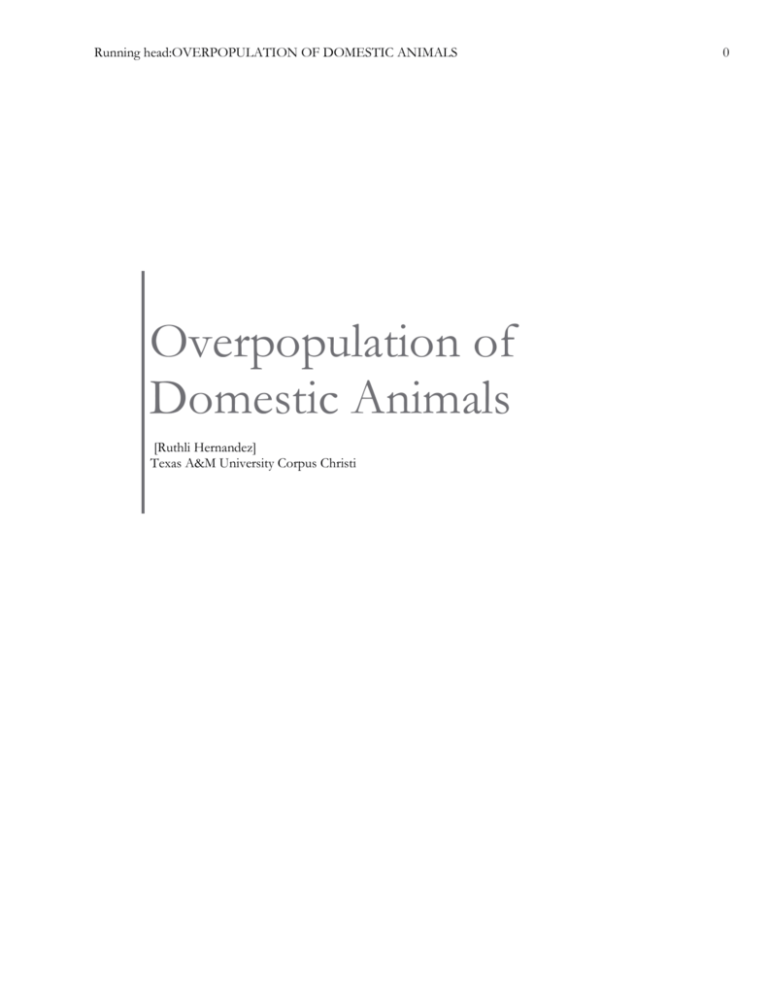
Running head:OVERPOPULATION OF DOMESTIC ANIMALS Overpopulation of Domestic Animals [Ruthli Hernandez] Texas A&M University Corpus Christi 0 OVERPOPULATION OF DOMESTIC ANIMALS Abstract This essay examines the overpopulation of domestic animals in the United States. The overpopulation is caused by millions of abandoned animals that the owners were no longer able to care for, and are left to fend for themselves. While on their own these domesticated animals reproduce without knowing the repercussions. In contrast some people oppose the funding of controlling this overpopulation and argue that it’s a case of survival of the fittess, each for their own. Unknowingly they don’t realize the animals become feral, or untamed and pose a threat to humans, which in the case they are looking for food or protecting themselves they can attack while possibly carrying rabies. While this has created a economic and social issue simply by having pets neutered or spayed everyone can help slow down the overpopulation of domestic animals. 1 OVERPOPULATION OF DOMESTIC ANIMALS 2 In American homes it is common to have domestic animal as a pet or companion. The overpopulation of domestic animals has reached a dangerously high point in the United States, putting to question our moral points of view. The context of domestic pet overpopulation means that there are more pets than homes available. Negligence has caused millions of domestic animals to become abandoned each year, which pose a threat to human health. Negligence is seen as when people are uneducated in owning them and having them breed freely. When owners are no longer able to care of their pets they abandon them to their own fate, which causes an overpopulation of domestic animals. Why is this affecting humans, Survival of the fittest let the circle of life go According to Brown (2006) 70% of households include a companion animal; furthermore, most people live with an animal than with a child. For this reason there are times when unwanted pet reproduction happens. When pets are in heat, a term used to describe a female who is looking for a mate to breed with, they find stray animals or other pets in the same household to mate with and reproduce. A problem arises when the domestic animal's offspring becomes too much for the owner to handle and can no longer feed and care for them. According to the American Society for the Prevention of Cruelty to Animals (ASPCA), the offspring of a single cat can produce an average of 60,000 kittens per year, while a single dog and its offspring can produce an average of 11,000 puppies per year (Rich & Finley, 2009). Therefore it is important to find homes for the offspring and have them sprayed or neutered for the prevention of future unwanted pets. OVERPOPULATION OF DOMESTIC ANIMALS 3 Neutered is the surgical procedure for a male animal in which the testicles are removed via a small incision; As for female animals they can be spayed which is the surgical procedure in which the ovaries and uterus are removed via abdominal surgery, leaving the animals unable to reproduce (Sexton, J. & Warhol, T., 2009). By simply having pets “fixed” it helps slowing down the overpopulation of these domestic animals. In the context of domestic pets, "overpopulation" means that there are more pets than homes available. People sometimes assume that by neutering an animal you hurt them or it’s inhumane. But in recent studies by Finkler, H., & Terkel, J. (2010) proved otherwise; In recent years, resulting from the growing populations of free-roaming cats in many cities worldwide, these cats are being managed using the Trap–Neuter– Return (TNR) method. The aims of this study were to explore the hypotheses that (a) neutering reduces aggression in the females living in such social groups; and (b) if such reduction does occur, that it might be accompanied by a reduction in cortisol (a stress hormone manufactured by the adrenal and pituitary glands) levels. The study was conducted on eight cat feeding groups in residential neighborhoods in Tel Aviv, Israel. The municipal veterinary department offers TNR services upon request. Cats are collected from the feeding group and returned to their original group after neutering. We found that neutered females showed reduced aggressiveness as well as reduced cortisol levels compared to the intact females. In addition, those intact females that displayed more aggression had higher cortisol levels compared to the less aggressive intact females. Based on the results of this study it is possible to suggest for the first time a possible OVERPOPULATION OF DOMESTIC ANIMALS 4 relationship between cortisol levels and aggression in free-roaming female domestic cats. This study is an initial step in assessing the long-term effects of Trap–Neuter–Return (TNR) on the welfare of the individual cat. If cortisol levels in female cats are reduced after neutering, partly as a result of reduced social and reproductive pressures (as expressed by lower aggression of the neutered females), it is possible that TNR has an added beneficial role in cat welfare in addition to that of control of population size. Therefore this shows that when cats are neutered they have less stress and are able to socialize easier with their surroundings while also preventing them from reproducing more offspring to our already overpopulated neighborhoods. When animals are raised by humans who feed, protect, and show affection to them, and then suddenly are thrown into the streets and are expected to fend for themselves when they have never done so. OVERPOPULATION OF DOMESTIC ANIMALS Brown, K. (2006). Pastoral concern in relation to the psychological stress caused by the death of an animal companion. Mental Health, Religion and Culture, 9, 411–422. Finkler, H., & Terkel, J. (2010). Cortisol levels and aggression in neutered and intact freeroaming female cats living in urban social groups. physiology & behavior, 99(3), 343-347. doi:10.1016/j.physbeh.2009.11.014 Issitt, M. & Morley, D. (2009). Counterpoint: domestic animal overpopulation leads to ecological destruction. points of view: domestic animal overpopulation, p3-3, 1p Nutter, F. B., Levin, J. F., & Stoskopf, M. K. (2004). Reproductive capacity of free-roaming domestic cats and kitten survival rate. Journal of the american veterinary medical association, 225(9), 1399-1402. retrieved from EBSCOhost. Rich, A. & Finley, L. (2009). Overpopulation of domestic animals is harmful to animals. Points of View: Domestic Animal Overpopulation, p2-2, 1p. Sexton, J. & Warhol, T. (2009) Domestic Animal Overpopulation: An Overview. Points of View: Domestic Animal Overpopulation, 2009, p1-1, 1p 5

